The TYAN Transport HX TN85-B8261 is a new dual-socket AMD EPYC 9004 platform, geared towards heavy storage I/O and GPU workloads. This barebones server can support up to two full-height double-width GPUs, 24 U.2 NVMe SSDs, as well as up to 6TB of DDR5 memory. In our review, we explore its performance leveraging dual AMD EPYC 96-core Genoa CPUs, as well as application-specific 128-core 9754S Bergamo CPUs with SMT disabled for HPC workloads.
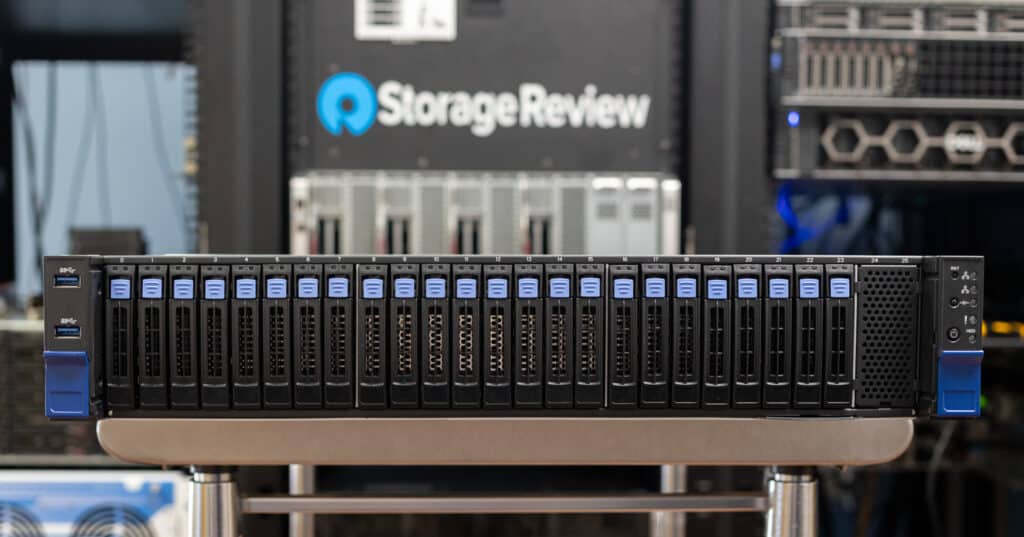
TYAN Transport HX TN85-B8261 Features
The ability to support two AMD EPYC 9004 Series Processors makes the Tyan Transport an ideal candidate for environments where computational power and storage capacity are paramount. Previous Tyan platforms in our lab supported the AMD EPYC 9004 Series CPU in a single-socket form, this is the first dual-socket AMD 9004 platform we’ve seen from the company.
Our server version offers 24 NVMe drive bays (with toolless caddies), catering to storage-heavy configurations. Tyan also offers a version with eight NVMe drives in front, using the lanes instead to support up to four 4 double-wide GPUs. The configuration choice depends on the user’s specific needs, whether it’s storage density or AI power.
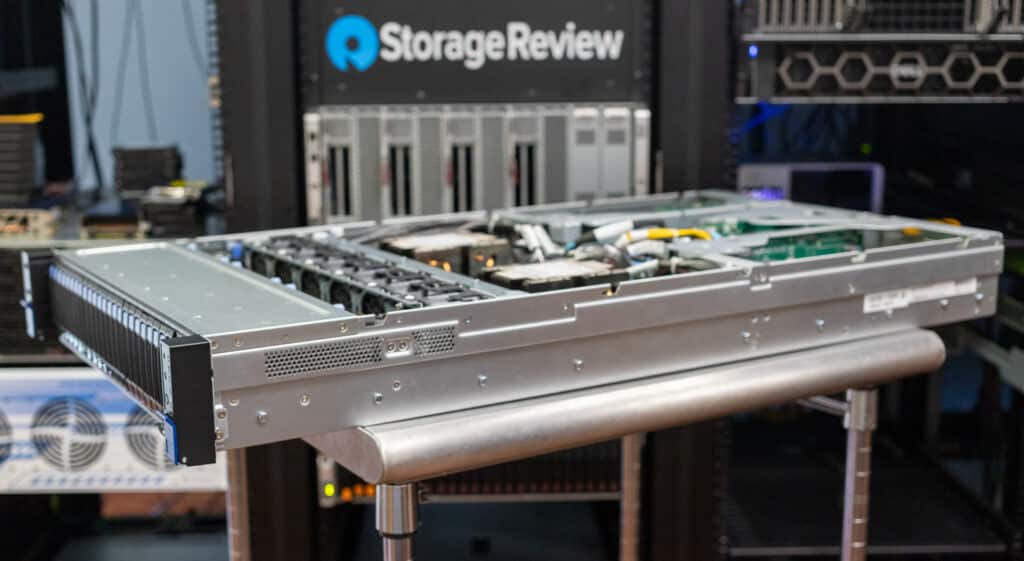
For memory support, the TN85-B8261 can accommodate RDIMM DDR5 memory at speeds up to 4800 MHz for one DIMM per channel (1DPC) and 3600 MHz for two DIMMs per channel (2DPC), along with 3DS RDIMM DDR5 3600MHz for 2DPC configurations. With support for up to 6,144GB of RDIMM/3DS RDIMM DDR5 memory (via 12 memory channels per CPU, for a total of 24), this server has the capabilities for an impressive DRAM footprint.
On the front panel’s left side are two USB 3.2 Gen.1 ports, and on the right are the reset and power buttons and the status LED indicators. Turning it around to the rear side reveals the test of the connectivity, including an additional two USB3.2 Gen.1 ports, two 10 GbE RJ-45 ports for high-speed networking, plus a dedicated GbE port for IPMI, a VGA port, and two hot-swap 2,700 Watt PSU modules. Two optional 60mm rear fans on either side are also supported, with power headers visible on the far left and right side of the chassis. These would be used in a situation that requires extra airflow for certain PCIe devices like accelerators.
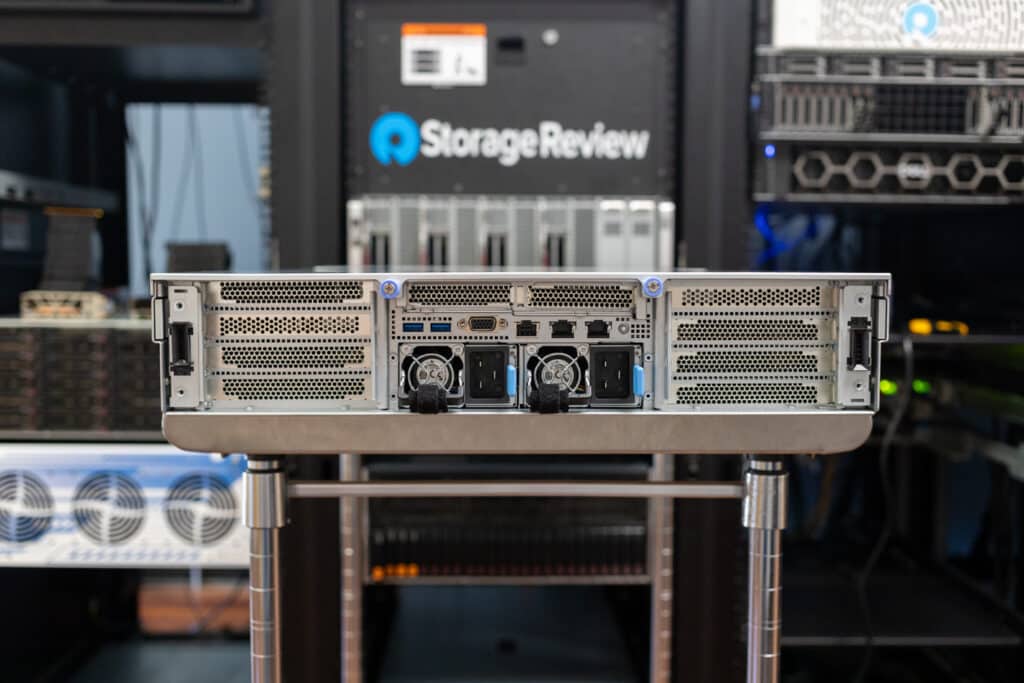
It took us a few minutes to figure out how to take the cover off to look inside; however, while doing that we got distracted and discovered an interesting ‘sunroof’ mini lid. Removing the panel provides easy access to the server’s six high-powered hot-swap fans and the NVMe bays.
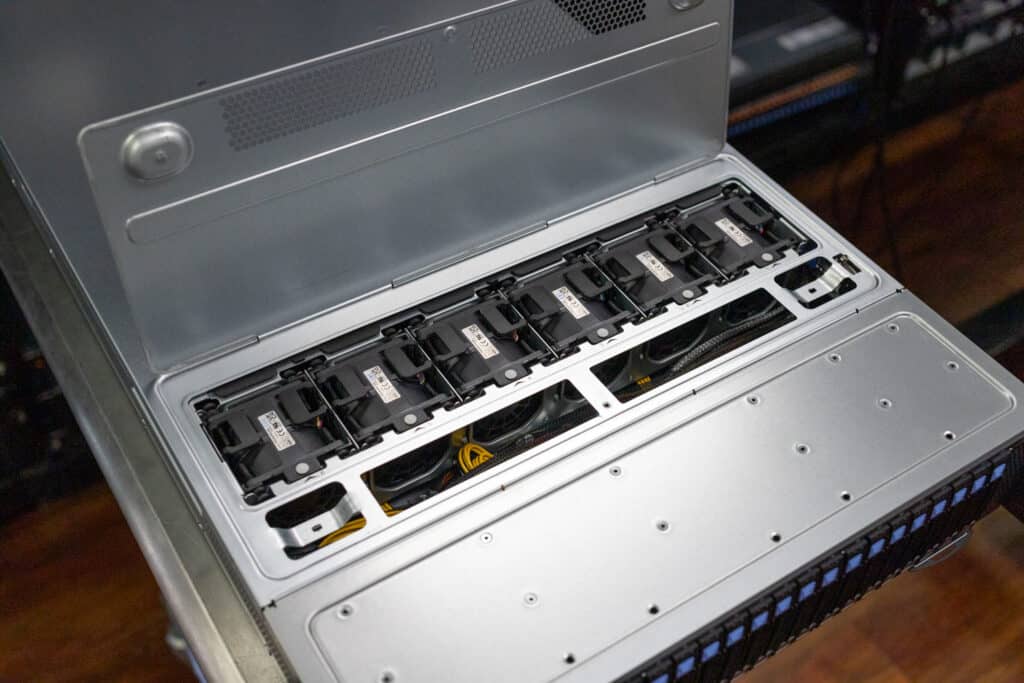
Upon removing the full lid, the first thing that stands out is that the TN85-B8261 features direct CPU access to all 24 NVMe bays, significantly enhancing performance and reducing latency for storage operations. This feature allows direct paths between the CPUs and the storage, ensuring that data-intensive applications perform at their peak without bottleneck issues. The one downside to this approach though is the need for all of these PCIe lanes, which limits the rear expansion options.
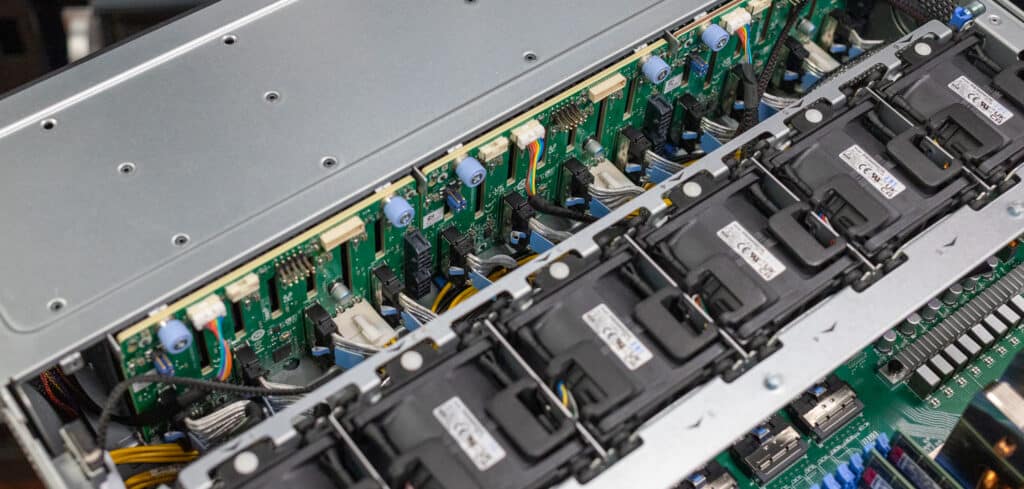
In the back, you can see the many PCIe cables connecting the front NVMe bays to different locations on the motherboard. In this photo you can see two PCIe cards loaded into the left and right side of the server, leaving one double-width full-height slot on each side for a GPU. In the middle are two half-height slots for other devices. In our setup, one slot is populated with a PCIe M.2 SSD sled.
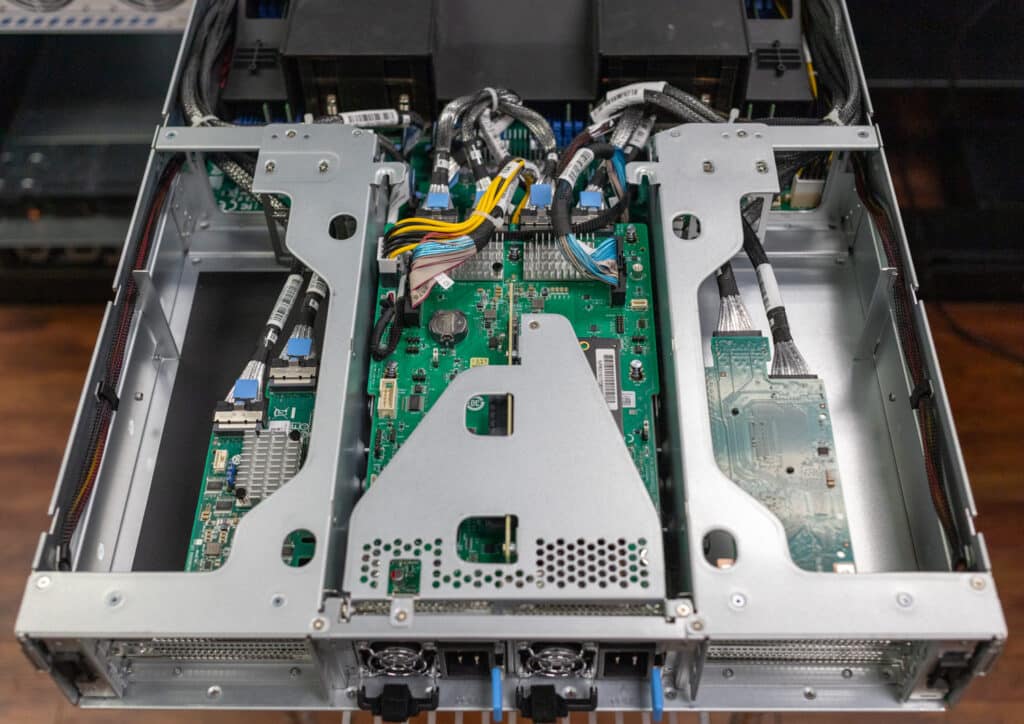
The TN85-B8261 server also has out-of-band server management features via the Aspeed AST2600 onboard chipset. The AST2600 chipset introduces the iKVM feature with 24-bit high-quality video compression support. This allows easy remote console access, which is crucial for managing servers in data centers or remote locations.
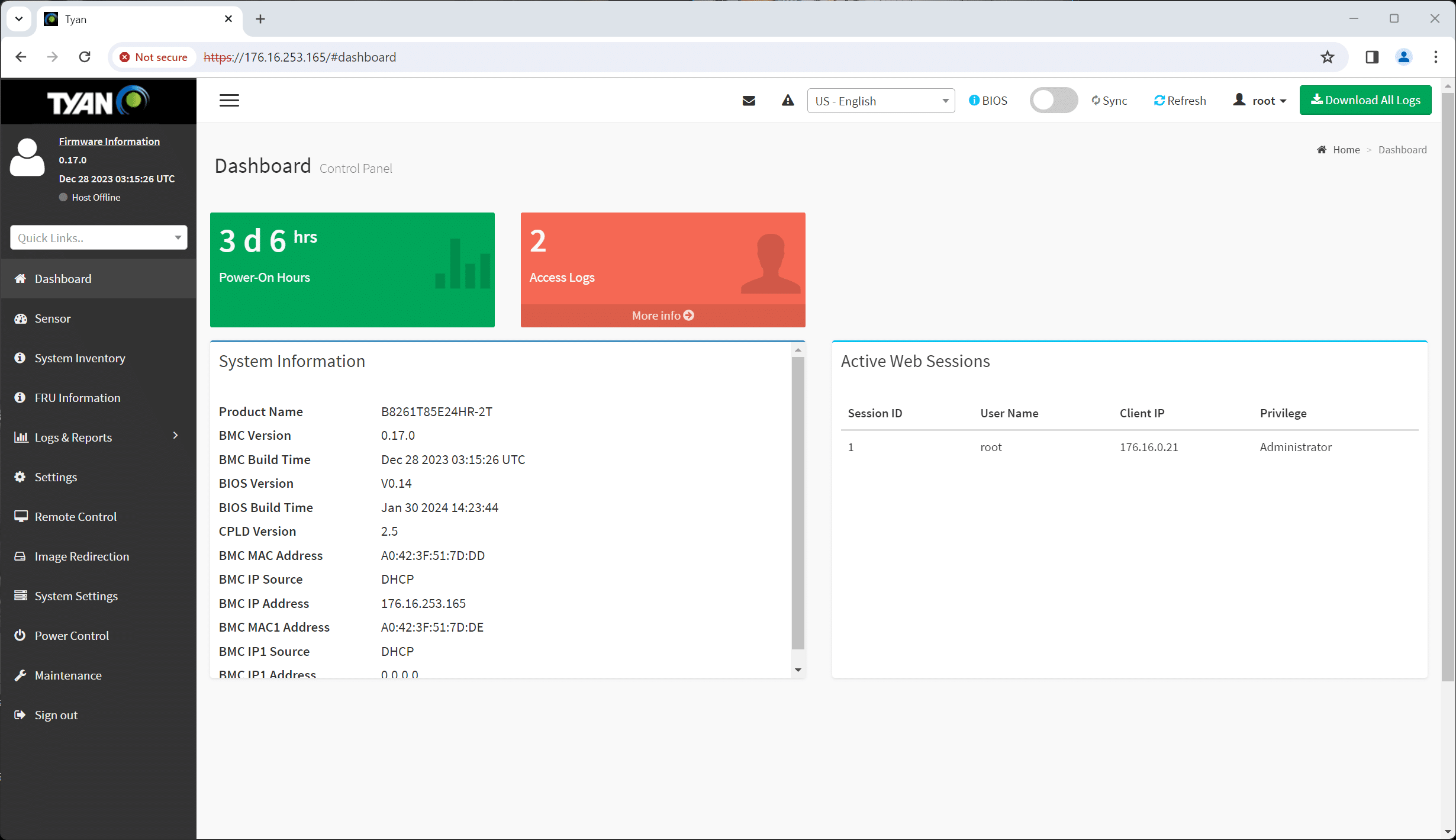
This feature also enables storage over IP, remote platform flash, and a USB 2.0 virtual hub. These capabilities let administrators perform a range of remote management tasks, like updating firmware or OS installation, without needing physical access to the server, ensuring operational efficiency and reducing downtime. This service leverages its own dedicated LAN port, separate from the two onboard 10GbE ports.
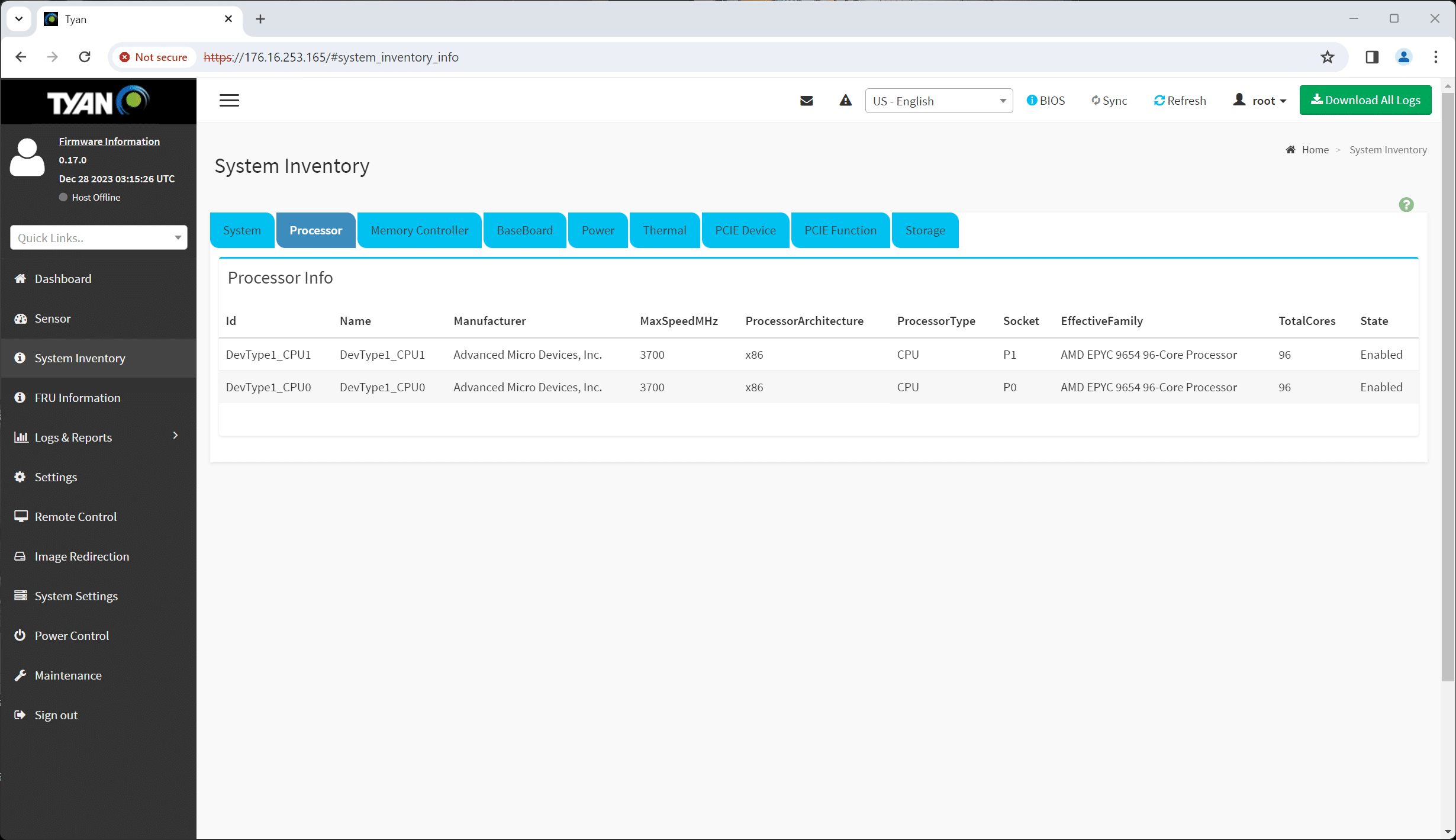
TYAN Transport HX TN85-B8261 B8261T85E24HR-2T Specifications
| System | Form Factor | 2U Rackmount |
| Chassis Model | TN85 | |
| Dimension (D x W x H) | 33.46″ x 17.63″ x 3.43″ (850 x 448 x 87mm) | |
| Motherboard Name | S8261GM2NE-2T # | |
| Motherboard Information | The motherboard is not sold separately | |
| Front Panel | Buttons | (1) PWR w/ LED / (1) UID / (1) RST |
| LEDs | (1) HDD / (1) ID / (2) LAN / (1) Warning | |
| I/O Ports | (2) USB 3.2 Gen.1 ports | |
| External Drive Bay | Q’ty Q’type | (8) 2.5″ Hot-Swap NVMe |
| Front Drive Bay Interface | (8) NVMe U.2 | |
| Front HDD Backplane Support | NVMe | |
| System Cooling Configuration | FAN | (6) 6cm hot-swap middle fans + (2) 6cm easy-swap rear fans |
| Power Supply | Type | CRPS |
| Input Range | AC 100-127V/14A / AC 200-240V/15.5A | |
| Frequency | 50/60 Hz | |
| Output Watts | 2,700 Watts | |
| Efficiency | 80 plus Titanium | |
| Redundancy | 1+1 | |
| Serviceability | Hot-swap | |
| Processor | Q’ty Q’tycket Type | (2) AMD Socket SP5 |
| Supported CPU Series | (2) AMD EPYC 9004 Series Processor | |
| Thermal Design Power Wattage | Max up to 400W (TDP) | |
| Memory | Supported DIMM Qty | (12)+(12) DIMM slots |
| DIMM Type / Speed | RDIMM DDR5 4800 MHz (1DPC) / 3600MHz (2DPC) / 3DS RDIMM DDR5 3600MHz (2DPC) | |
| Capacity | Up to 6,144GB RDIMM/3DS RDIMM DDR5 4800/4000 memory | |
| Memory channel | 12 Channels per CPU | |
| Memory voltage | 1.1V | |
| Expansion Slots | PCIe | (6) PCIe Gen.5 x16 slots |
| Pre-installed TYAN Riser Card (PCIe Gen.5) | (1) M8261T85-LR32-2L riser card for (2) HH/HL PCIe 5.0 x16 slots / (1) M8261T85-L32T-2F riser card for (2) FH/FL PCIe 5.0 x16 slots / (1) M8261T85-R32T-2F riser card for (2) FH/FL PCIe 5.0 x16 slots | |
| LAN | Q’ty / Port | (2) 10GbE ports + (1) GbE dedicated for IPMI |
| Controller | Intel X550-AT2 | |
| PHY | Realtek RTL8211F | |
| Storage NVMe | Connector (U.2) | (4) SFF-TA-1016 (MCIO 8x) for (8) front NVMe |
| Graphic | Connector type | D-Sub 15-pin |
| Resolution | Up to 1920×1200 | |
| Chipset | Aspeed AST2600 | |
| I/O Ports | USB | (2) USB3.2 Gen.1 ports (@ front) / (2) USB3.2 Gen.1 ports (@ rear) |
| VGA | (1) D-Sub 15-pin port | |
| RJ-45 | (2) 10 GbE ports + (1) dedicated GbE for IPMI | |
| Button | ID Button / Power Button / Reset Button | |
| TPM (Optional) | TPM Support | Please refer to our TPM-supported list. |
| Interface | SPI | |
| System Monitoring | Chipset | Aspeed AST2600 |
| Temperature | Monitors temperature for CPU & memory & system environment | |
| Voltage | Monitors voltage for CPU, memory, chipset & power supply | |
| LED | Over temperature warning indicator / Fan & PSU fail LED indicator / Over voltage warning indicator | |
| Server Management | Onboard Chipset | Onboard Aspeed AST2600 |
| AST2600 iKVM Feature | 24-bit high-quality video compression / Supports storage over IP and remote platform-flash / USB 2.0 virtual hub | |
| AST2600 IPMI Feature | IPMI 2.0 compliant baseboard management controller (BMC) / 10/100/1000 Mb/s MAC interface | |
| BIOS | Brand / ROM size | AMI / 32MB |
| Feature | Hardware Monitor / FAN speed control automatic / Boot from USB device/PXE via LAN/Storage / Console Redirection / SMBIOS 3.5/PnP/Wake on LAN / ACPI 6.4 / ACPI sleeping states S0, S5 | |
| Operating Environment | Operating Temp. | 10° C ~ 35° C (50° F~ 95° F) |
| Non-operating Temp. | – 40° C ~ 70° C (-40° F ~ 158° F) | |
| In/Non-operating Humidity | 90%, non-condensing at 35° C | |
| Regulation | FCC (SDoC) | Class A |
| CE (DoC) | Class A | |
| Operating System | OS supported list | Please refer to our AVL support lists. |
| RoHS | RoHS 6/6 Compliant | Yes |
| Package Contains | Barebone | (1) TN85-B8261 Barebone |
TYAN Transport HX TN85-B8261 Performance
To provide a comprehensive performance analysis, our benchmarks encompass a variety of intensive tests, each targeting different aspects of CPU performance. We use Blender OptiX for rendering performance, Blackmagic to assess video processing capabilities, and Geekbench for overall system performance evaluation. Cinebench will give us insights into graphics and rendering efficiency, y-cruncher for mathematical computations, and 7-Zip compression tests to gauge data processing and compression speeds.
This review will focus on the compute side of things rather than storage performance.
Tyan Transport HX TN85-B8261 main components:
- 8 x 64GB Kingston DDR5 RAM
- Tested on Windows Server 2022
We used two different CPU configurations for benchmarking: the 96-core AMD EPYC 9654 and the 128-core AMD EPYC 9754S (SMT Disabled). This analysis will show the performance benefits of using processors with higher core counts and enhanced capabilities within the same system architecture. By contrasting these EPYC 9004 CPUs, we can highlight the potential gains in processing efficiency and task execution speed. We also compared it to two Dell PowerEdge Servers powered by one, and two, of the AMD EPYC 9354 32-core processors just to show scale within the AMD CPU family.
Blender OptiX
Blender is an open-source 3D modeling application. This benchmark was run using the Blender Benchmark utility. The score is samples per minute, with higher being better.
The Blender OptiX benchmark on the Transport HX TN85-B8261 server, comparing dual AMD EPYC 9654 (96 cores) and AMD EPYC 9754S (128 cores), reveals interesting performance differences in 3D modeling tasks. In the “Monster” scene, the 128-core EPYC 9754S slightly outperforms the 96-core EPYC 9654, showing a modest improvement in rendering speed with 1,480 samples per minute versus 1,448.
However, in the “Junkshop” scene, the 96-core configuration leads with 1,009 samples per minute, compared to 943 for the 128-core setup. This indicates that more cores (without SMT) don’t guarantee better performance for all rendering tasks. The “Classroom” scene results are nearly identical, suggesting that the advantage of additional cores diminishes for certain types of workloads.
| Blender OptiX Version 4.0 (CPU) (Samples per minute; Higher is better) | Transport HX TN85-B8261 (2x AMD EPYC 9654, 96 cores) |
Transport HX TN85-B8261 (2x AMD EPYC 9754S, 128 cores) |
Dell PowerEdge R7625 (2x AMD EPYC 9354) | Dell PowerEdge R7615 (AMD EPYC 9354) |
| Monster | 1,448 | 1,480 | 726 | 375 |
| Junkshop | 1,009 | 943 | 474 | 248 |
| Classroom | 748 | 758 | 389 | 198 |
Blackmagic RAW Speed Test
We have also started running Blackmagic’s video playback speed test. This is more of a hybrid test that includes CPU and GPU performance for real-world RAW decoding.
| Blackmagic RAW Speed Test (Higher is better) | Transport HX TN85-B8261 (2x AMD EPYC 9654, 96 cores) |
Transport HX TN85-B8261 (2x AMD EPYC 9754S, 128 cores) |
Dell PowerEdge R7625 (2x AMD EPYC 9354) |
Dell PowerEdge R7615 (AMD EPYC 9354) |
| 8K CPU | 63 fps | 60 fps | 53 fps | 59 fps |
| 8K CUDA | N/A | N/A | N/A | N/A |
UL Procyon AI Inference
UL Procyon AI Inference is designed to gauge a workstation’s performance in professional applications, although it should be noted that this test does not take advantage of multiple CPU capabilities. Specifically, this tool benchmarks the workstation’s ability to handle AI-driven tasks and workflows, providing a detailed assessment of its efficiency and speed in processing complex AI algorithms and applications.
The results span a range of AI models, indicating the server’s versatility to handle different types of AI workloads.
| UL Procyon Average Inference Times (Lower is better) |
Transport HX TN85-B8261 (2x AMD EPYC 9654, 96 cores) |
Transport HX TN85-B8261 (2x AMD EPYC 9754S, 128 cores) |
Dell PowerEdge R7625 (2x AMD EPYC 9354) | Dell PowerEdge R7615 (AMD EPYC 9354) |
| MobileNet V3 | 3.54 | 5.81 | 5.54 | 4.27 |
| ResNet 50 | 14.85 | 26.75 | 20.61 | 18.39 |
| Inception V4 | 44.69 | 71.99 | 80.08 | 70.70 |
| DeepLab V3 | 43.13 | 59.10 | 65.35 | 59.17 |
| YOLO V3 | 61.19 | 90.76 | 92.37 | 84.89 |
| Real-ESRGAN | 3,908.70 | 4,529 | 5,691.98 | 5,233.51 |
| Overall Score | 92 | 62 | 60 | 68 |
The UL Procyon AI Inference benchmark with dual AMD EPYC 9754S (128 cores) reflects increased inference times across various AI models compared to its 96-core counterpart. For example, inference times for MobileNet V3, ResNet-50, Inception V4, DeepLab V3, and YOLO V3 all increased, suggesting that additional cores do not improve AI task performance linearly. The Real-ESRGAN model‘s time significantly rose to 4529, indicating complex tasks might not benefit directly from more cores. The overall score dropped to 62 from 92, highlighting that higher core counts don’t guarantee better AI inference efficiency.
y-cruncher
y-cruncher is a multi-threaded and scalable program that can compute Pi and other mathematical constants to trillions of digits. Since its launch in 2009, it has become a popular benchmarking and stress-testing application for overclockers and hardware enthusiasts.
The y-cruncher benchmark results for the Transport HX TN85-B8261 illustrate a clear pattern: the 128-core configuration consistently performs better across all computational tasks, from calculating 1 billion to 25 billion digits of Pi. This is one test where SMT disabled really shines.
For computing 1 billion digits, the 128-core CPU completed the task in 13.764 seconds, compared to 15.088 seconds by the 96-core CPU, showing a noticeable improvement. This trend of enhanced performance by the 128-core configuration is consistent as the complexity of the task increases. At 2.5 billion digits, the time reduced from 26.626 to 23.266 seconds; at 5 billion digits, from 45.696 to 40.520 seconds; and for 10 billion digits, from 83.853 to 77.635 seconds. The most extensive computation tested, 25 billion digits, saw a reduction from 213.950 to 201.693 seconds.
| y-cruncher (Total Computation time) | Transport HX TN85-B8261 (2x AMD EPYC 9654, 96 cores) |
Transport HX TN85-B8261 (2x AMD EPYC 9754S, 128 cores) |
Dell PowerEdge R7625 (2x AMD EPYC 9354) | Dell PowerEdge R7615 (AMD EPYC 9354) |
| 1 billion digits | 15.088 | 13.764 | 22.868 | 36.686 |
| 2.5 billion digits | 26.626 | 23.266 | 56.678 | 98.68 |
| 5 billion digits | 45.696 | 40.520 | 118.455 | N/A |
| 10 billion digits | 83.853 | 77.635 | N/A | N/A |
| 25 billion digits | 213.950 | 201.693 | N/A | N/A |
Geekbench 6
Geekbench 6 is a cross-platform benchmark that measures overall system performance. You can find comparisons to any system you want in the Geekbench Browser.
The Transport HX TN85-B8261 AMD configurations show distinct results for single-core and multi-core performance. The 96-core configuration scored higher in both tests: 2,043 for single-core and 15,609 for multi-core performance, compared to 1,708 (single-core) and 15,229 (multi-core) for the 128-core configuration. These results indicate that the additional cores in the 128-core configuration do not translate to higher scores in the Geekbench 6 evaluation, especially in single-core performance, where the 96-core version has a clear advantage.
The difference is narrower in multi-core performance, but the 96-core still leads, suggesting that the benchmark may not be optimal for SMT-disabled CPUs.
| Geekbench 6 (Higher is better) |
Transport HX TN85-B8261 (2x AMD EPYC 9654, 96 cores) |
Transport HX TN85-B8261 (2x AMD EPYC 9754S, 128 cores) |
Dell PowerEdge R7625 (2x AMD EPYC 9354) |
Dell PowerEdge R7615 (AMD EPYC 9354) |
| CPU Single-Core | 2,043 | 1,708 | 2,074 | 2,070 |
| CPU Multi-Core | 15,609 | 15,229 | 13,487 | 12,049 |
| GPU | N/A | N/A | N/A | N/A |
Cinebench R23
This benchmark uses all CPU cores and threads to generate an overall score.
Here, the AMD EPYC 9754S (128 cores) config significantly outperforms its 96-core counterpart in multi-core performance with scores of 132,994 to 83,092, respectively. This highlights the 128-core configuration’s superior capability in handling tasks that benefit from more cores.
However, in the single-core test, the TYAN server’s 96-core AMD EPYC 9654 CPUs score higher with 1,304 compared to 1,096 for the 128-core version. This suggests that the 96-core processor may have an advantage in per-core efficiency or clock speeds that benefit single-threaded tasks.
The MP Ratio, which indicates the efficiency of multi-core performance relative to single-core performance, shows a significant difference: 121.34x for the 128-core setup versus 63.74x for the 96-core setup. This larger ratio for the 128-core configuration reflects its enhanced ability to scale performance across more cores, demonstrating its effectiveness in highly parallel computing environments.
| Cinebench R23 (Higher is better) |
Transport HX TN85-B8261 (2x AMD EPYC 9654, 96 cores) |
Transport HX TN85-B8261 (2x AMD EPYC 9754S, 128 cores) |
Dell PowerEdge R7625 (2x AMD EPYC 9354) |
Dell PowerEdge R7615 (AMD EPYC 9354) |
| Multi-Core | 83,092 | 132,994 | 88,551 | 52,401 |
| Single-Core | 1,304 | 1,096 | 1,338 | 1,343 |
| MP Ratio | 63.74x | 121.34x | 66.20x | 39.03x |
Cinebench 2024
In Cinebench 2024, which incorporates Redshift renderer testing, the TYAN Transport HX TN85-B8261 with dual 96-core EPYC 9654 CPUs outperforms the 128-core configuration in both multi-core (3,277 vs. 2,703) and single-core (75 vs. 68) tests. The MP Ratio also shows a higher efficiency for the 96-core setup (43.28x) compared to the 128-core (39.91x).
| Cinebench R23 (Higher is better) | Transport HX TN85-B8261 (2x AMD EPYC 9654, 96 cores) |
Transport HX TN85-B8261 (2x AMD EPYC 9754S, 128 cores) |
Dell PowerEdge R7625 (2x AMD EPYC 9354) | Dell PowerEdge R7615 (AMD EPYC 9354) |
| Multi-Core | 3,277 | 2,703 | 2,974 | 2,014 |
| Single-Core | 75 | 68 | 76 | 71 |
| MP Ratio | 43.28x | 39.91 | 38.95x | 28.29x |
7-Zip Compression
The built-in memory benchmark in the popular 7-Zip utility demonstrates the CPU performances of each machine. We run this test at a 128MB dictionary size when possible.
The dual 128-core AMD EPYC 9754S configuration demonstrates superior performance over the 96-core EPYC 9654 setup across compressing and decompressing tasks. The 128-core setup achieves a staggering 5,706 percent and 5,741 percent CPU usage for compressing, with GIPS ratings of 2.789 and 2.783, respectively, significantly outpacing the 96-core’s 4,339 percent and 4,362 percent CPU usage with lower GIPS ratings of 1.857 and 1.855. This indicates a more efficient utilization of the processor’s cores in parallel tasks.
For decompression, the 128-core configuration similarly outperforms, showing CPU usage rates of 6,211 percent and 6,168 percent, with GIPS ratings improving to 4.625 and 4.586, compared to the 96-core’s 4,708 percent and 4,656 percent CPU usage and lower GIPS ratings of 4.721 and 4.817. The total rating for the 128-core configuration stands impressively at 221.301 GIPS, compared to the 96-core’s 152.589 GIPS, emphasizing the enhanced performance and efficiency in handling data-intensive operations offered by the additional cores.
| 7-Zip Compression Benchmark (Higher is better) | Transport HX TN85-B8261 (2x AMD EPYC 9654, 96 cores) |
Transport HX TN85-B8261 (2x AMD EPYC 9754S, 128 cores) |
| Compressing | ||
| Current CPU Usage | 4,339% | 5,706% |
| Current Rating/Usage | 1.857 GIPS | 2.789 GIPS |
| Current Rating | 80.595 GIPS | 159.182 GIPS |
| Resulting CPU Usage | 4,362% | 5,741% |
| Resulting Rating/Usage | 1.855 GIPS | 2.783 GIPS |
| Resulting Rating | 80.923 GIPS | 159.755 GIPS |
| Decompressing | ||
| Current CPU Usage | 4,708% | 6,211% |
| Current Rating/Usage | 4.721 GIPS | 4.625 GIPS |
| Current Rating | 222.278 GIPS | 287.250 GIPS |
| Resulting CPU Usage | 4,656% | 6,168% |
| Resulting Rating/Usage | 4.817 GIPS | 4.586 GIPS |
| Resulting Rating | 224.254 GIPS | 282.848 GIPS |
| Total Rating | ||
| Total CPU Usage | 4,509% | 5,955% |
| Total Rating/Usage | 3.336 GIPS | 3.684 GIPS |
| Total Rating | 152.589 GIPS | 221.301 GIPS |
Conclusion
The TYAN Transport HX TN85-B8261 is tailored to leverage the capabilities of the new AMD EPYC 9004 Series (in our case, equipped with the 128-core 9574S and 96-core 9654), positioning itself as a versatile powerhouse suitable for a broad spectrum of applications. Its design optimizes high-performance computing, data analytics, and enterprise storage, underscoring its adaptability to various operational needs.
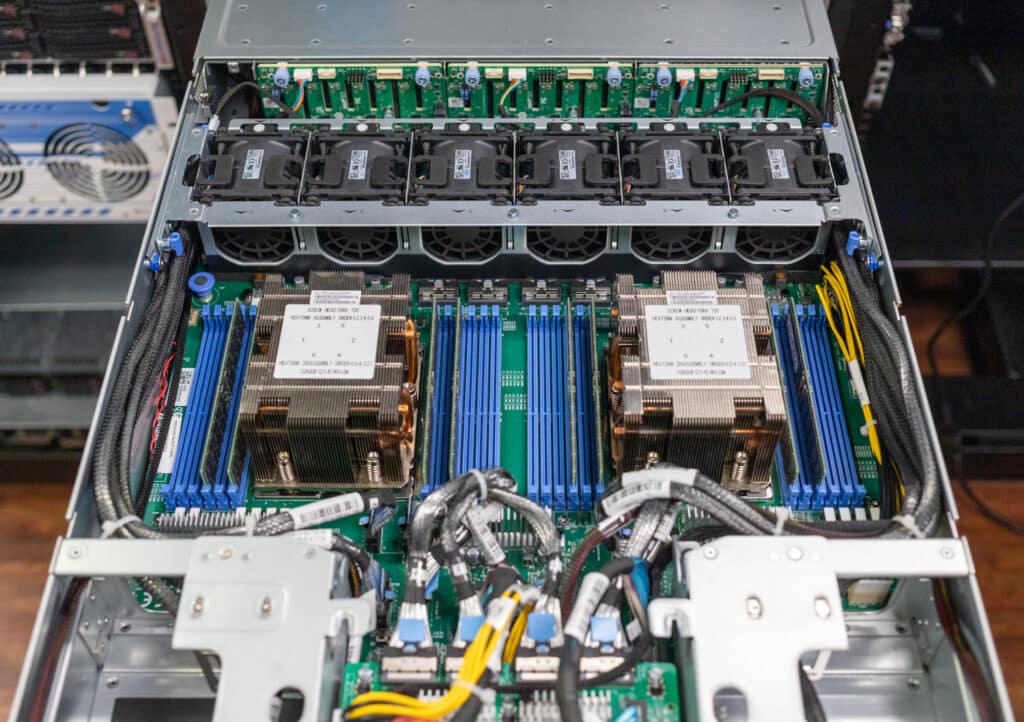
With support for up to 24 NVMe drive bays and DDR5 memory, the TN85-B8261 excels in storage density and speed, which is crucial for data-intensive applications. The direct CPU access to NVMe bays enhances performance and reduces latency, further boosting its storage capabilities.
The server can also be configured to accommodate GPU-heavy needs. The B8261T85E8HR-2T-N variant offers support for up to four double-wide accelerators (alongside eight NVMe slots) dedicated to maximizing computational power for graphics processing. This allows the TN85-B8261 to easily adapt to many roles, including high-performance computing tasks like data analytics and AI and machine learning workloads where GPU acceleration is crucial.
Adaptability as either a GPU-heavy server or storage-heavy server with support for the latest AMD EPYC CPUs makes the TYAN Transport HX TN85-B8261 family quite versatile. The server should provide a strong return on investment for organizations venturing into computationally demanding projects.




 Amazon
Amazon